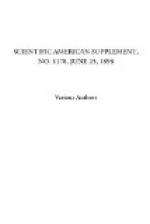* * * * *
The proposal of Gov. Black, which has now become law, to depute to Cornell the care of a considerable tract of forest land, and the duty of demonstrating to Americans the theory, methods and profits of scientific forestry, has a curious appropriateness much commented on at the university, since two-thirds of the wealth of Cornell has been derived from the location and skillful management of forest lands, the net receipts from this source being to date $4,112,000. In the course of twenty years management the university has thrice sold the timber on some pieces of land which it still holds, and received a larger price at the third sale than at the first. The conduct of this land business is so systematized that the treasurer of the university knows to a dot the amount of pine, hemlock, birch, maple, basswood and oak timber, even to the number of potential railroad ties, telegraph poles and fence posts on each fourth part of a quarter section owned by Cornell. Certainly, Cornell is rich in experience for the business side of a forestry experiment such as Gov. Black proposes. The university forest lands from which its endowment has been realized are in Wisconsin.
* * * * *
Books may be called heavy when the qualifying term is not applied to their writers, but to the paper makers. It is falsifications in the paper that give it weight. Sulphate of baryta, the well known adulterate of white lead, does the work. A correspondent, writing to The London Saturday Review, gives the weight of certain books as: Miss Kingsley’s “Travels in Africa.” 3 pounds 5 ounces; “Tragedy of the Caesars,” 3 pounds; Mahan’s “Nelson” (1 vol.), 2 pounds 10 ounces; “Tennyson” (1 vol.), 2 pounds 6 ounces; “Life and Letters of Jowett” (1 vol.), 2 pounds 1 ounce. To handle these dumb-bell books, The Saturday Review advises that readers take lessons in athletics.




